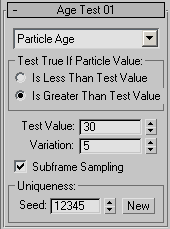 Command entry: Particle View
Command entry: Particle View  Click Age Test in an event or add Age Test to the particle system and then select it.
Click Age Test in an event or add Age Test to the particle system and then select it.
Age Test lets the particle system check whether a specific amount of time has passed since the start of the animation, or how long a particle has existed, or how long a particle has been in the current event, and branch accordingly.

The user interface appears in the parameters panel, on the right side of the Particle View dialog.
The first interface element is a drop-down list that lets you choose the type of age to test. Default=Particle Age.
Lets you specify whether the test passes particles on to the next event if the age test succeeds or fails. Default=Is Greater Than Test Value
By default, Age Test returns True if the value tested for exceeds the Test Value quantity, but you can alternatively choose Is Less Than Test Value. For example, if you use the Absolute Age test type and set Test Value=60 and Variation=0, and choose Is Less Than Test Value, then particles will move to the next event only until frame 60. After frame 60, any remaining particles stay in the current event unless another test returns True.
The number of frames by which the value tested for can vary randomly. Default=5.
This value cannot be animated.
To obtain the actual test value for each particle, the system multiplies the Variation value by a random number between -1.0 and 1.0, and then adds the result to the Test Value setting. For example, if Test Value=300 and Variation=10, then tested value for each particle would be between 290 and 310.
Turning this on helps avoid particle "puffing" when passing particles to the next event by testing the time at a much higher subframe resolution (that is, throughout each frame), rather than using the relatively coarse frame resolution. Default=on.
"Puffing" is the effect of creating separate "puffs" or clusters of particles, rather than a continuous stream.
Turn off Subframe Sampling to cause the test to be executed exactly at frame times.